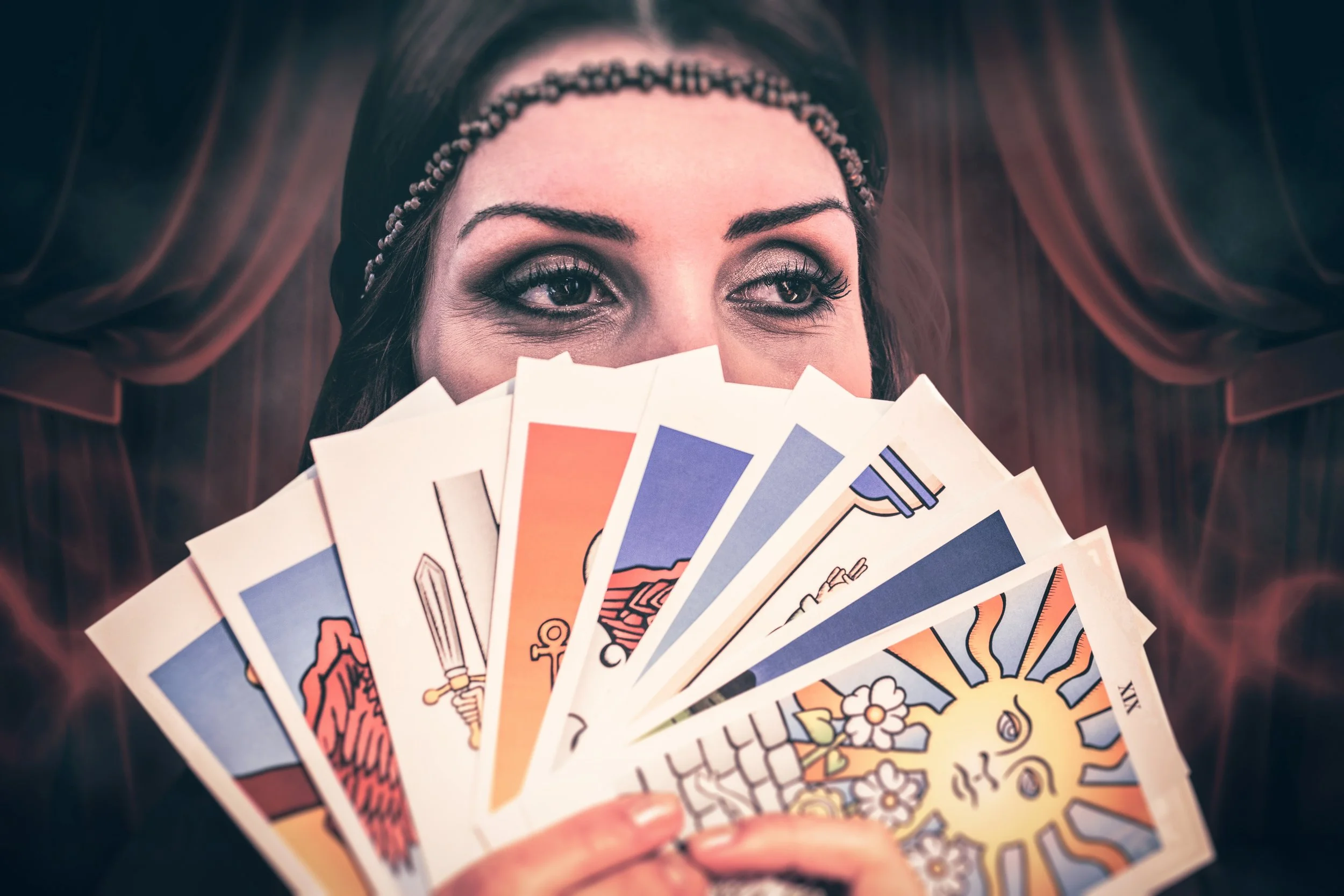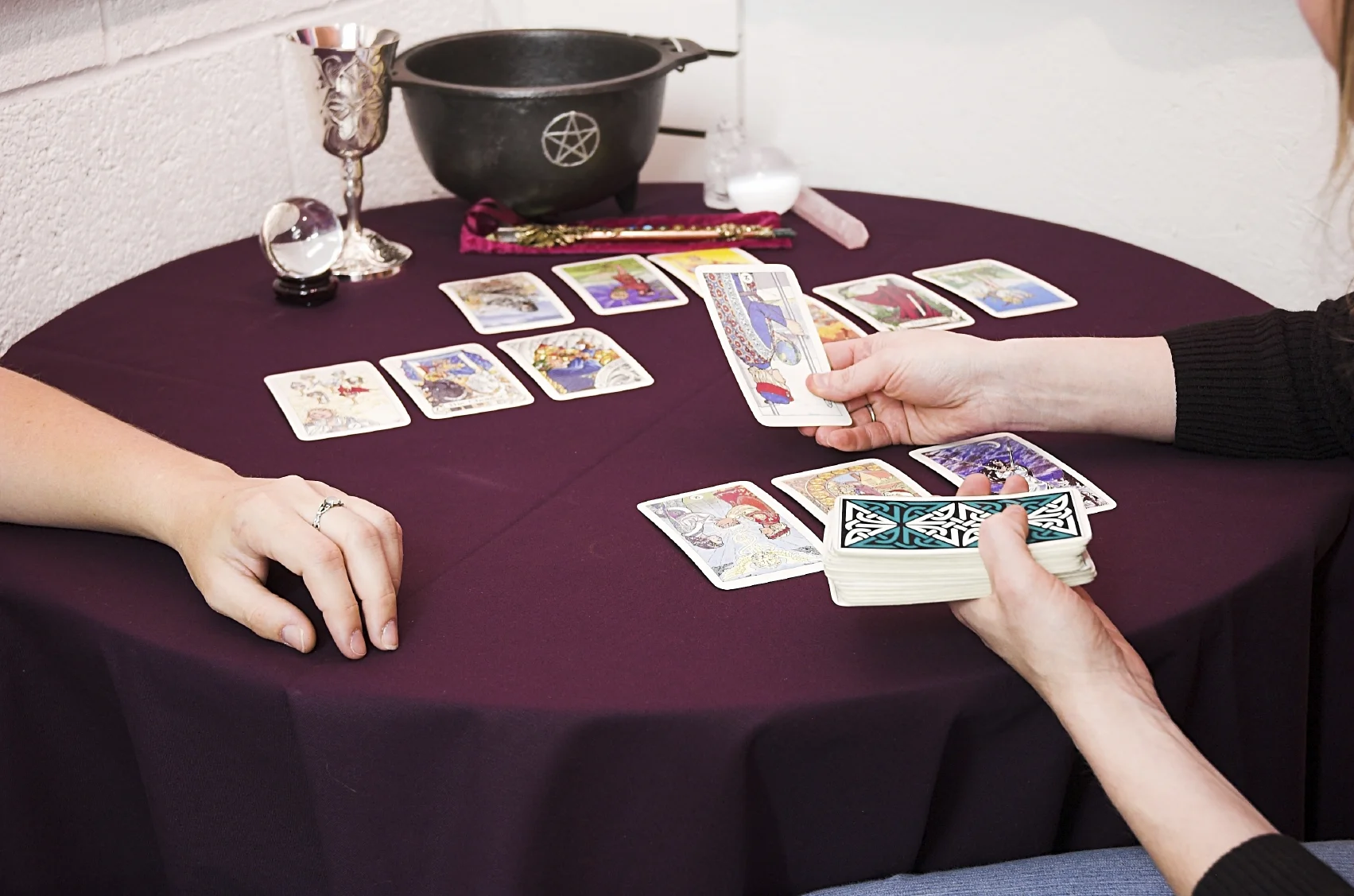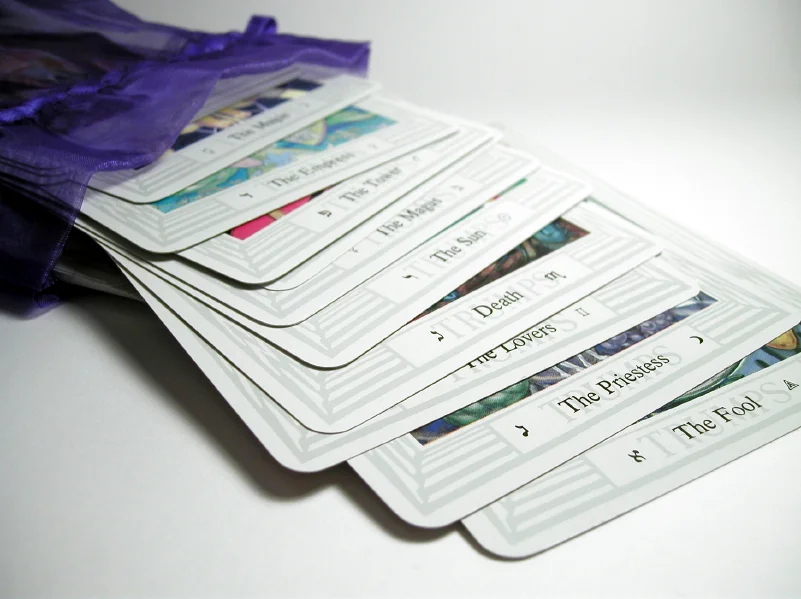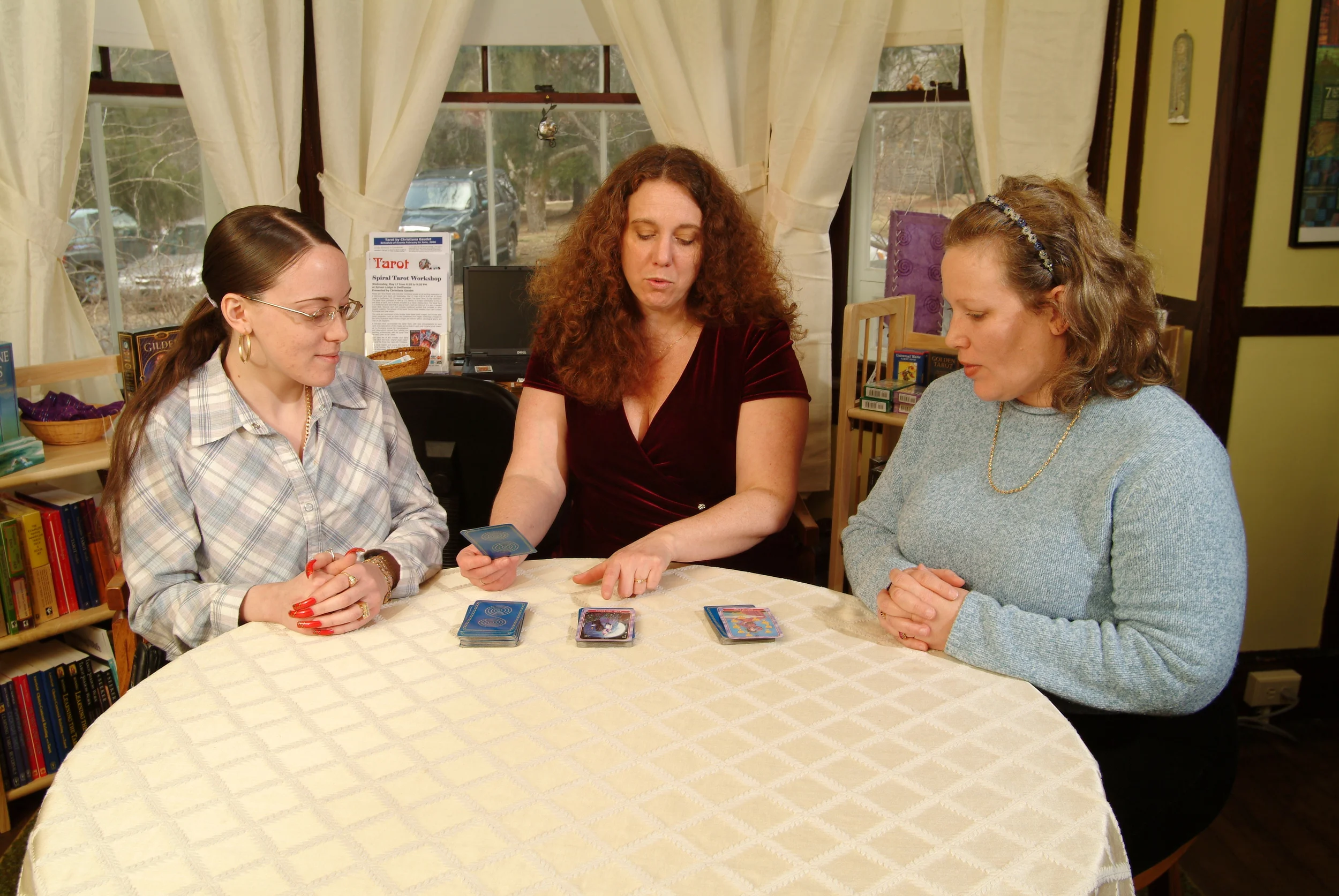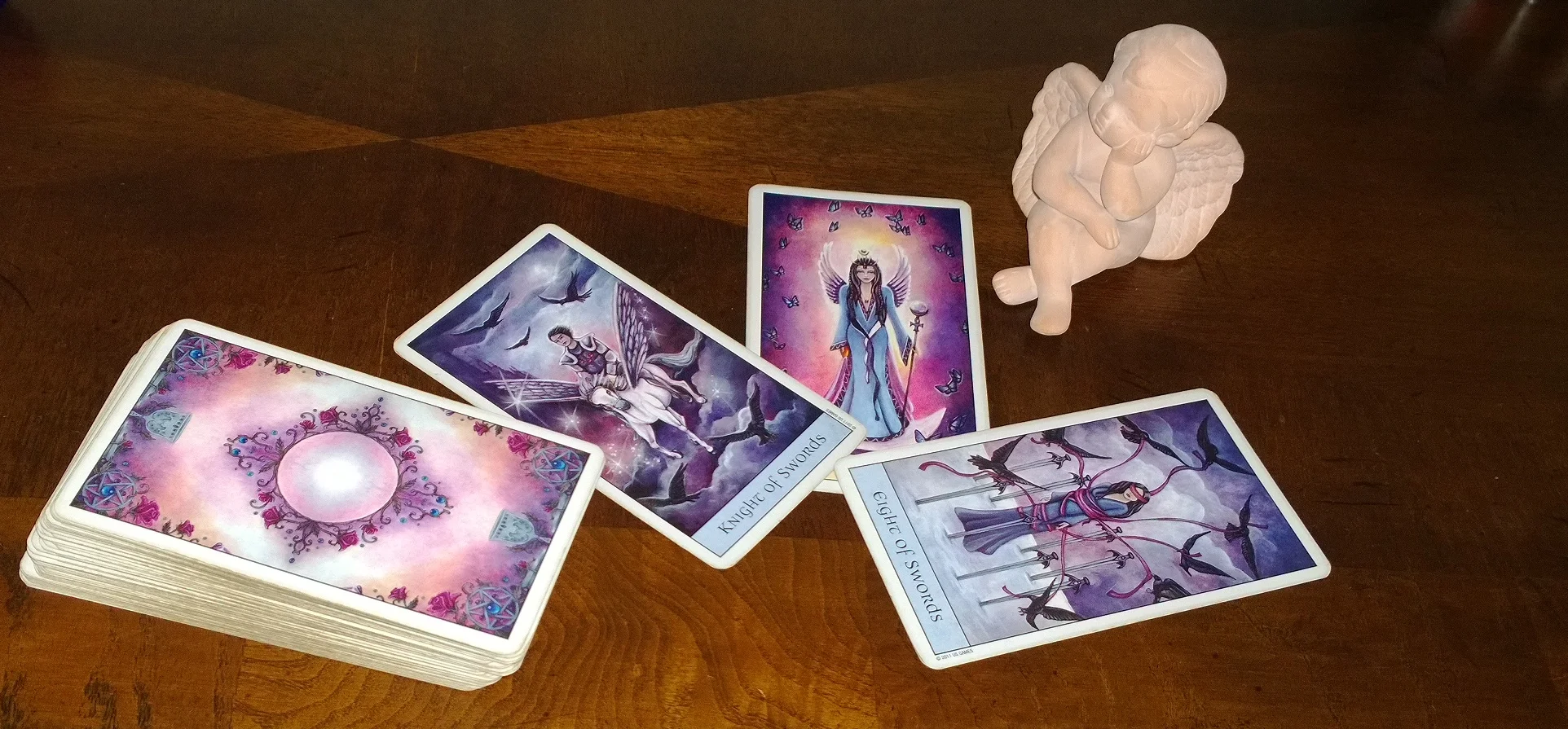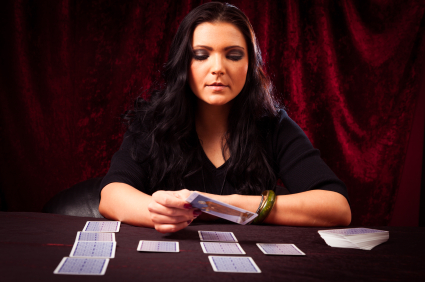
Welcome to my Community Blog for tarot enthusiasts.
Anyone with an interest in tarot, be they student, artist, collector, writer, teacher or reader, is welcome to
to include here.
Superstition Doesn’t Mix Well with Tarot
The more superstitious we are, the less spiritual we are.
Superstition Doesn’t Mix Well with Tarot
The more superstitious we are, the less spiritual we are.
I am not a superstitious person, though I have fun with the traditions of some superstitions. I will throw salt over my left shoulder if I spill it, and I announce that a man is coming to dinner if I drop a knife. Yet, I don’t worry about bad luck should I forget to throw the salt. Nor do I set an extra place for a stranger at dinner.
Some people think it is strange that I am a full-time professional tarot reader and not superstitious. To me, it makes perfect sense. Tarot is a proven tool, when used appropriately. Superstitions, when taken seriously, seems to be borne of fear and idiocy, and seem to increase and create both.
Superstitious people who use tarot rarely gain the many benefits tarot has to offer because they are too busy ascribing supernatural attributes to cardboard rather than using the cards to find the magic within themselves.
This is a difficult distinction for a couple of reasons. Tarot does seem to operate magically. The cards can speak truth in uncanny ways. The tarot images feel sacred to us. It is both easy and appropriate to revere tarot as one might revere a sacred text like the Bible.
I believe that tarot works well because it works with the third eye, or brow chakra, by stimulating our eyesight when we see the cards, and then stimulating our imagination and intuition. Vision, imagination and intuition are all seated in the brow chakra. These things work together to help us create a tarot reading.
No one really knows for sure why random token divination of any kind works as well as it does. People have ascribed all kinds of theories to it, understandably. The Golden Dawn felt that the angel Hru presides over tarot. Many of us feel that spirits speak to us through tarot. Still others feel that the power that makes the tarot work resides within the cards themselves. There is nothing wrong with any of those theories, until we start to use those theories to absolve ourselves of our own responsibilities as diviners.
When we start to feel that we are getting bad readings because our decks are angry at us, we step into superstition and step away from real spiritual practice. When we blame a deck for a faulty reading rather than looking at our own mistakes in interpretation, we are as bad as any fundamentalist in any religion. When we use the practice of a “deck interview” to decide how we will work with a deck rather than deciding to learn the deck and try actual readings with it we are artificially limiting the deck and ourselves.
When we are receiving cards that don’t make sense, it is our job to study until they do make sense. When we blame those nonsensical cards on the deck itself, we have lost the opportunity to learn and grow, as tarotists and as people.
Whatever rituals we use to honor our deck and keep it holy, we are remiss if those rituals don’t include our own study, our own psychic development and our own meditation.
When we rely on our superstitions about tarot to provide the parameters of our tarot practice, our tarot practice will always be limited by those superstitions, and by the lack of scholarship they allow us.
Dear Tarot Student: Don’t Try to Be Good at Tarot
The point of studying tarot is personal growth.
Dear Tarot Student
Don’t Try to Be Good at Tarot
So often new and intermediate tarot students tell me they worry that they aren’t any good at tarot. I tell them they are missing the point.
It is true that at a particular level of tarot study and practice we want to tap into intuitive and interpretive talent. It’s also true that at the professional level you need to be good or go home.
Yet, I firmly believe that the study of tarot is beneficial to everyone. When I was a child in Sunday School we didn’t worry if we were good at Bible study. We learned the parables and discussed their meanings, and from that we grew. Tarot is the same way.
When we study tarot, the focus on card memorization can be daunting and discouraging. Some tarotists never memorize keywords, classic interpretations or archetypes. Gifted professional intuitives often use tarot as a prop, or as a focal point for inspiration, without ever knowing any traditions of tarot interpretation. I believe they aren’t technically tarot readers and are missing the wisdom of the tarot, but they get the job done.
Some students enjoy flashcard-style memorization and have a knack for it. Others don’t. Yet, tarot study doesn’t have to include a focus on tarot memorization, and, for many of us, probably shouldn’t.
Tarot study has a personal and spiritual value above and beyond building our skill at reading for others or predicting the future.
Each tarot card teaches a spiritual lesson. When we study tarot, those lessons inform our lives and hasten our healing. As a result of that process, we learn the meanings of the cards without really trying.
If you are frustrated with your tarot practice, you may be trying too hard to divine, and not hard enough to learn the lessons of the cards. If you are too focused on memorization without understanding the lessons and applying those lessons to your life, you are missing the point entirely.
In the beginning of your tarot practice, worry less about whether you are good at tarot, and worry more about discovering how tarot is good for you.
How to Discover your Inner Tarot Reader: An Eight-Point Guide
What is a tarot reading? Is it simply the process of interpreting some cards pulled at random?
Yes and no.
Any tarotist, and any tarot client, will tell that that something special happens in a good tarot reading; something beyond the recitation of standard card interpretation. A tarot reading is a process during which information is received, connections are made, truth is heard and inspiration happens.
A tarot reading is a separate thing from both the tarot cards and the tarot reader. A tarot reading has a life of its own.
The question is, how can you make this process, the process of tarot reading, happen? Of course you must study, and learn your cards. But you also have to practice actually giving readings. And, if you wait until you really feel like you know your cards inside out you’ll wait forever. You have to jump in and start using your cards. Here are some of the important points you’ll want to consider as you discover your inner tarot reader.
Point 1. Understand this important truth. There is no one right way to perform a tarot reading. It’s good to try different techniques, and even to invent techniques.
Point 2. How much tarot knowledge you may have is not as important as your ability to tap in to your intuition and to be an open channel. When you go to your cards it should be second nature to breathe, focus, ground, center, pray, create sacred space, invoke elements and entities, meditate, or do whatever works for you to make sure that you are in the proper space to give a reading.
Point 3. How you begin your reading is up to you. You can ask a question, or start with an overview. You can lay out cards in a spread, with designated positional meanings, or a pattern with no specific positional meanings.
Point 4. How you interpret the cards is up to you. The techniques you can use range from classic interpretations to allowing yourself to intuit your reading based on what you see in the images and how they make you feel.
Point 6. There are correlations between tarot and astrology, numerology, Kabballah, the Four Elements, and other esoteric and philosophical systems. You can use any of these you want in your interpretations, or none at all.
Point 7. However you arrive at your card interpretations, you must interpret the cards based on the position in a positional spread, the question, if indeed a question was asked, and the surrounding cards. These contextual concerns are what makes the ultimate difference between a reading that feels personal, specific and on-point, and a reading that feels general and uninspired.
Point 8. Keep your personal opinions out of the mix. This can be difficult. You will form opinions based on what you see in the cards – that’s the point. But you will probably have other opinions too, based on your own personal experience. No matter what the subject matter, interpret the cards and give the reading. Leave your soap box at home.
When you enter into the process of tarot reading, you will tap in to internal resources you didn’t even know you had. When you find your inner tarot reader, you will also find your inner confidence, creativity and spiritual connection.
As you can see, there is no one right way to do a tarot reading. However, you must have a sense of what techniques work for you, and how you, personally, perform your best readings. Practice, study and innovation are all important parts of learning to give a great tarot reading!
If you are truly interested in being the best reader you can be, make sure you check out my upcoming premium webinar, Sharing Wisdom – Reading for Others!
Stop Fixing the Hierophant!
Modern tarot creators enjoy stretching tarot to fit every possible theme and worldview. That’s a good thing. Tarot’s ability to speak universally, using the imagery of so many cultures, is part of its awesome power.
I believe it is the strength and power of the tarot archetypes that allow tarot this much flexibility. Unfortunately, it is possible to stretch a card so far beyond its archetype that you lose the archetype entirely.
We are all aware of the trend to rename some of the more difficult Major Arcana cards. Death becomes Transition; the Devil becomes Materialism, and so on. We often discuss this trend in terms of the dark cards, the Tower, the Devil and Death.
Another Major Arcana card that often receives this same treatment at the hands of deck creators is the Hierophant. Weirdly, there is generally very little protest when a well-intentioned modern deck mangles this particular archetype.
I think deck creators’ tendency to mangle the Hierophant, and our tendency to put up with it, comes from two factors. First is the way most tarotists seem to feel about Hierophant energy. We don’t like rules and structure. We fear the religious hierophants in our own community who discriminate against us and disrespect us. Of course, we don’t want any of them in our tarot decks!
The second factor is that we seem to lack a basic understanding of the Hierophant. Because we don’t understand him, we don’t see his value along the Fool’s Journey.
I can think of three well-loved tarot decks that, in my opinion, really get the Hierophant wrong.
The first and oldest is Motherpeace, my second-ever tarot deck. In Motherpeace, the Hierophant is a man wearing false breasts, pretending to be a woman. Clearly, sensitivity toward the transgender community was not on the minds of these deck designers when they were creating the then-definitive feminist tarot of the 1980s.
The idea behind this vision of the Hierophant is that the matriarchy is the keeper of true spiritual authority. By pretending to be a woman, the Hierophant is trying to claim an authority that is not his. Trust me, this played better in the 1980s than it does now.
Modern spiritual decks with Pagan and New Age themes often try to “fix” the Hierophant. Tarot of Transformation renamed him “Spiritual Leaders” and used the key phrase “Taking the Hierophant off the Pedestal.” Chrysalis Tarot calls the Hierophant the “Divine Child” and says this in its LBW (Little White Book) to justify the change.
“Most tarot decks title this card the Hierophant, a religious authority figure. In Chrysalis Tarot, the task of spiritual growth is an individual responsibility that requires an open mind and critical thinking.”
To me, this kind of thinking shows an incomplete understanding of the Hierophant and of tarot in general. When we fail to embrace the Hierophant, and all the archetypes of tarot, we become unable to gain the knowledge, wisdom, insight and divinatory intelligence that tarot can provide.
Five hundred years ago, the Hierophant was the Pope. That’s why we see him as a religious authority. When we consider the position held by the Roman Catholic Church in Italy at the time of tarot’s emergence, we understand that the Pope was not just a religious authority, he was the ultimate authority.
Today, the Hierophant speaks to authority in relevant and important ways. To remove the Hierophant’s authority, as the three decks I mentioned have done, removes an important piece of the tarot puzzle, and risks making tarot less effective.
In a reading, the Hierophant can represent the rules and the authority of any “church.” That can be the “church” of medicine, law, or governance, of corporate, educational or military structure or spiritual doctrine.
When we need to submit ourselves to the church of medicine for surgery, we need the Hierophant, a surgeon who knows every piece of the doctrine, rather than a Divine Child who wants us to figure it out ourselves.
When we earn an academic honor, we have become expert in the doctrine of the Hierophant, not the introspection of a Divine Child.
In a reading, the Hierophant can suggest consulting a doctor or an attorney. The Hierophant can encourage your professional authority as a manager or a business owner. When the Hierophant appears to suggest these things, he commands our respect for the due process we all must endure. A Divine Child has no need or respect for due process, achievement, or a learned body of knowledge.
When we understand and portray tarot in a limited way, we limit the power of tarot. Right now, we seem to be inclined to limit the powers of the Hierophant.
When we examine the way our culture processes a tarot card, we understand something about our culture. At a time of corrupt governments, disenfranchised citizenry and economic disparity, none of us like the Hierophant energy very much.
The answer, though, is not to engage in navel-gazing and withdrawn self-discovery. The answer is to earn your own authority, and wield it wisely. That’s the way to change the authoritarian structures of the hierophants that don’t serve us. At the same time, when you need an authority – a doctor, a lawyer, a priest, you really can’t accept any substitutes.
Sometime the Hierophant comes up in a reading to describe a stubborn and didactic personality. The Hierophant has told me of a client’s dogmatic Evangelical husband, whom she would later divorce. The Hierophant has told me of a client’s spiritual leader who was abusing her sexually. The Divine Child in the same place would not have been able to communicate these things to me.
Our discomfort with the Hierophant is understandable. However, when we remove the Hierophant from tarot we miss the opportunity to explore the dichotomy of this specific energy. When does honoring tradition build our community, and when does it oppress us? When do we need the authority of a body of knowledge, and when is it best to trust or inner guidance?
True enlightenment comes from both studied knowledge and intuitive wisdom. The Hierophant is an important part of that journey. Through studying difficult tarot images, and seeing the ways in which they speak in readings, we learn about ourselves, and our society. The tarot archetype of the Hierophant is complex, and irreplaceable.
Aces, Tens and the Court: Tarot Exercises to Find your Path
Separate from your Minor Arcana the four Aces, four Tens, and all sixteen Court cards, separated by rank. As we explore each number and rank, consider how the suit/element is expressed in each card.
Aces: Aces are a new beginning, the source or the essence of their element. The Ace is the purest form of the element.
Shuffle your four Aces, and ask this question: What is a source of strength upon which I could draw more fully?
Pull one card to give your answer. What card did you receive? What does it mean to you?
Tens: Tens represent a fullness, or the completion of a cycle or a journey.
Shuffle your four Tens, and ask this question: What am I full of right now?
Pull one card to give your answer. What card did you receive? What does it mean to you?
Now look at your Ace and your Ten together. How does your Ace give you strength to help you with your Ten?
Pages: Pages refer to youth, learning and communication.
Shuffle your four Pages, and ask this question: What am I learning right now?
Pull one card to give your answer. What card did you receive? What does it mean to you?
How does the lesson of your Page tie in to the story told in your Ace and Ten?
Knights: Knights refer to coming of age, travel and pursuit.
Shuffle your four Knights, and ask this question: What should I be pursuing right now?
Pull one card to give your answer. What card did you receive? What does it mean to you?
Queens: Queens refer to mature feminine wisdom, and nurturance.
Shuffle your four Queens, and ask this question: What is my source of wisdom right now?
Pull one card to give your answer. What card did you receive? What does it mean to you?
Kings: Kings refer to masculine leadership, and authority.
Shuffle your four Kings, and ask this question: Where should I take a leadership role right now?
Pull one card to give your answer. What card did you receive? What does it mean to you?
Now look at your Knight, your Queen and your King. How do these three energies support you in taking your next steps forward in life?
Take all six cards you have drawn today, and shuffle them. Pull one to give you a final thought. Pay special attention to it’s number/rank and it’s element. What direction does this card give you?
Compare, Contrast, Contemplate: A Deeper Way to Learn Tarot
Tarot is more than divination, more than prediction, and more than interpretation. Tarot is a book of spiritual wisdom in picture form.
Tarot Techniques that go Beyond the Spread
Many people have asked me to describe some of my most successful reading techniques. Here are some easy-to-follow bullet lists to show you the methods I use to give readings that go beyond the simple spread.
Begin the Reading
Start with a comprehensive spread, such as the Celtic Cross or the Rainbow Spread. Before you interpret individual cards in their positions, notice and interpret:
- Colors, images and cards that “jump out” at you.
- The ratio of Major Arcana to Minor Arcana.
- Which suits are present, and in what quantities.
- Which suits are missing.
- Numbers, by sets and by runs within a suit.
- Court cards, and consider who or what they may represent, and how they relate to each other.
- The ratio of reversals to upright cards.
- Where significant cards appear spatially.
When interpreting the spread, do not:
- Be confined to card-by-card interpretations.
- Struggle to fit a card’s interpretation into the position in which it falls. The position is a suggestion or a guide only.
- Pretend to understand something. If it doesn’t make sense, say so!
When interpreting the spread, do:
- Look for information about the client’s personality.
- Use it as an opportunity to get to know your client, and the situations at hand.
- Use it to develop further questions, and figure out areas you would like to further explore.
- Decide if there are cards that are most significant, and why.
- Make note of anything you do not understand to try to figure out later in the reading.
Go Beyond the Spread
- Make note of the cards in the original spread, either mentally or on paper. Then pick them up and shuffle them back into the deck.
- Address each question or topic one at a time, by asking a question and picking cards to answer it.
- Look for cards from the original spread to show up again.
- Pay attention to trends, as you did in the original spread.
- Remember key words when interpreting the cards, and pay attention to how key words make sense in light of the question. Use the key words in your answers to describe situations, people and emotions.
Ask the Questions
- Yes or No questions, or direct questions trying to predict the future, are not as effective as asking “What is the likelihood of. . .” or “What should I expect . . .” or “How should I prepare for. . .” .
- When asked to read about a person who is not present, ask the client for some information about the person, such as name and age, and simply pull a few cards to see what shows up about this person.
- It is always helpful to ask “What about. . .” a person, idea, plan, job etc., and pull a few cards.
- If your client is shy about asking questions, remember that most people are interested in knowing about their career, family, home and spiritual purpose.
Pull the Cards
- Pick a few cards off the top of the deck and lay them on the table.
- Pick a few cards off the top of the deck and hold them in your hand in a fan.
- Spread the cards face down on the table and have the client pick a few.
- Spread the cards face down on the table and have you or the client hold a hand over them and feel the pull of the energy in the cards.
- Spread the cards face up and have the client choose the images that call to them.
- Be intuitive about the number of cards you pick, or keep picking until it feels right, or keep picking until you reach a Major Arcana card.
- Once you have a few cards on the table, move them around until you can make a sensible story of them.
- Ask the client to comment on the images, or the feelings that the cards evoke.
- If you are reading over the phone and the client cannot see the images, give the keywords or describe the images to get feedback and involve the client.
- If you are not sure about the meaning of a particular card, ask the question “What is this card trying to tell me?” and pull another card to answer it.
Incorporate Other Tools and Skills
- Use a pendulum, another oracle, palmistry or psychic skills such as psycometry to confirm your Tarot reading, or to “flesh out” your reading.
- The Tarot is limitless in the information it can give. Feel empowered to use it to aid you in spirit communication, to give information about pets, dream interpretation or past lives if the reading calls for it.
Conclude the Reading
- Ask for, and answer, any final questions.
- Recap the important points of the reading, and suggest a theme for the reading.
- Make any necessary referrals (counselor, doctor, attorney, auto mechanic etc.).
- Have the client draw a one last card or token from another oracle to give some final insight.
The Value of Small Tarot Spreads
In professional tarot reading, I like to use larger tarot spreads in order to get a more complete picture. But I also like to use small tarot spreads, too. A small spread can be only one, two or three cards.
There are a few reasons smalls spreads are helpful. First, if you are a new reader, small spreads will give you practice, and opportunity to learn the cards in action, without overwhelming you. Second, if you have only a short time in which to perform a divination, a small spread can give you the information you need quickly. Third, you can use a small spread, or many small spreads, as part of a longer comprehensive reading.
Here are some ideas for working with small spreads. These might be especially helpful to new readers, or readers interested in developing some helpful new techniques.
Interpreting Cards in Small Spreads
If you are a new reader, or a looking to get a new perspective on card reading, ask yourself these questions about each card you interpret.
-
How does the card make me feel?
-
What do I see in the image?
-
What do I know about the card?
-
What are the traditional interpretations (check books, class materials, Google)?
One-Card Readings
While a single-card pull can’t always give all the information you might want, pulling a single card in answer to a question can be a great way to check in with the Universe. Single card readings can also lead to dialogues with the cards which can provide a great deal of information.
For one-card readings, ask a specific question that is open-ended.
“What do I need to know about my job?”
“How should I prepare for my trip?”
“How can I best support my friend?”
When Interpreting Spreads of more than one care, you have the opportunity to see how the cards combine and influence each other, Consider:
What do the cards have in common, and what does that tell you?
How do the cards contrast, and what does that tell you?
Two-Card Spreads
Here are some two-card spreads to try.
-
Help and Hinder: How would a particular situation or solution help me, and how would it hinder me?
-
Either/Or: What do I need to know about my options?
-
Partnership (Why are we in each other’s lives?)
Three-Card Spreads
Here are some three-card spreads to try.
-
Past/Present/Future
-
Morning/Afternoon/Evening
-
Body/Mind/Spirit
-
Relationship
When performing small spreads, be specific about your questions.
A simple Past/Present/Future reading will make more sense if you give it specific questions, such as:
- What has been my spiritual purpose in the past, in the present, and what will it be in the future?
- What lessons did I learn in the past, what lessons am I learning now, and what will I learn in the future?
- What was my greatest asset in the past, what is it now, and what will it be in the future?
- What was my biggest challenge in the past, what is it now, and what will it be in the future?
The Body/Mind/Spirit Reading works better like this:
- What must I do to better support my body, mind and spirit?
- What are my biggest concerns regarding my body, mind and spirit?
- What is the greatest strength of my body, mind and spirit?
Daily practice with small spreads will give your tarot skills a lot of versatility and flexibility. Adding small spreads to your reading style will allow you the opportunity to produce a great deal of helpful information each time you consult the cards.
Five Ways to Interpret a Reversed Tarot Card
In tarot, a card is considered “reversed” if it appears in a tarot spread upside down. Not ever tarot deck, tarot tradition or tarot reader honors reversals.
For me, reversals add a great deal more nuance and texture to a reading. I encourage my students to pay attention to reversals and consider them in their interpretations.
Some readers choose not to honor reversals because the practice just doesn’t resonate for them. That’s fine. Part of becoming a great tarot reader is to figure out what really works and doesn’t work for you.
I suspect that a lot of tarot students would prefer to take advantage of the extra information reversals can give them, but have a hard time with the actual interpretations.
Some readers, and teachers, have a hard-and-fast approach to reversals, claiming that reversals will always denote a specific thing. In my experience this has not been true.
Some readers and teachers believe that reversals are always negative, or always an opposite, of the card’s original energy. For me, there is no “always” when it comes to reversals.
I find that reversals are most helpful when we give them some wiggle remove. Rather than saying that a reversal will always be a particular thing, it is better to say that a reversal changes the energy of the card in some way.
Here are five ways a reversal can affect the interpretation of a card.
-
Too Much
A reversal can indicate an over-abundance of the card’s energy. For instance, the Queen of Cups reversed may be over-emotional or depressed. The Three of Cups reversed could indicate too much partying.
-
Too Little
Sometimes a reversal can indicate a lack of the card’s energy. For instance, the Four of Swords reversed could indicate a busy period, and the need for rest and retreat.
-
Opposite
Yes, sometimes a reversal can be an opposite. The Hermit reversed could indicate social activity, for instance.
-
Avoidance
Sometimes the reversal indicates a tendency to avoid the energy of the card. For instance, the Five of Wands reversed might indicate a person who tries to avoid conflict.
-
Relief/Release
Sometimes a reversal (especially of a difficult card) can put the energy of the card in the past. This may indicate a recovery or release from the energy of the card. For example, the Devil reversed might come up for a person who has quit smoking.
The next time you see a reversed card in your tarot spread, consider which of these possibilities might bring more clarity to your reading.
Answers to Your Questions about Tarot: Who and What is this Reading for Anyway?
Here’s a question from Erin, who writes, in part:
Hi Christiana!
When you're reading for a client or friend, how do you know you aren't channeling your OWN energy and issues into the cards, and therefore getting a reading for yourself, rather than the client? What if the person isn't in the room with you, and you're doing it over the phone- then I am the one shuffling and laying the cards, so how can you be sure the reading will be for the other party? Is setting the intent with the 'spirits/guides/powersthatbe' enough?
Another related question; when you put your intention into a reading, do you ever find that your guides (or whomever you believes gives you the responses) will seem to talk about something other than what you intended to ask about?
For example; right now I am voraciously going after new jobs, it's all consuming, and my cards are sick of hearing about it I'm sure!
But, I said "tell me something about my love life" and the cards I got seemed to be NOT related to love, but related to my career issue instead. I'm very intuitive, and thought I didn't write down the cards for this reading, it was very obvious that the cards weren't interested in talking about my love life at the moment. Which, could be the message, "Erin, sort out your professional shit before you even try and get involved with a man."
What do you think?
Great question, Erin! I hope you enjoy the video!
In short, setting the intention for whom the reading is for is as easy as saying the person’s name, or simply focusing on the person, while shuffling the cards.
If something you hear yourself saying in the reading resonates as a message for you, don’t disregard the possibility that the message is meant for both of you. Just because it resonates for you don’t invalidate it for the client.
It is also true that if you are doing readings in group, more than one person might resonate with a particular message. Generally, if it resonates for you, it is your message, too! Having more than one person resonate with a message does not make the message less valuable for anyone.
Tarot is a tool of archetypes, that is, universal themes, characters and experiences. Since tarot speaks to universal experiences it makes sense that more than on person may be experiencing the same themes at the same time.
I think, too, the Universe often arranges to have us hear messages, even when we didn’t ask for them specifically. The more tuned in we are with our cards the more this will happen.
This is a different phenomenon than psychic leak, which is when one person’s information leaks into another person’s reading. If you read for more than one person in the same room you may experience psychic leak. Pay attention to when and how often this happens. Over time you will learn how you skills work and learn to anticipate, deal with and avoid psychic leak.
When it comes to intentions for questions, you are right, it can be difficult. The cards will often give you the focus the Universe thinks you need, rather than addressing the issue that is top of mind for you at the moment.
You can certainly ask questions and draw cards about why the focus needs to be in a particular area, or why your question can’t be answered at this time.
Thanks for a great question, Erin, and enjoy the video!
Email your questions about tarot to me!
Christiana Answers Questions about Intention in Tarot Readings
Video of Christiana Answers Questions about Intention in Tarot Readings
